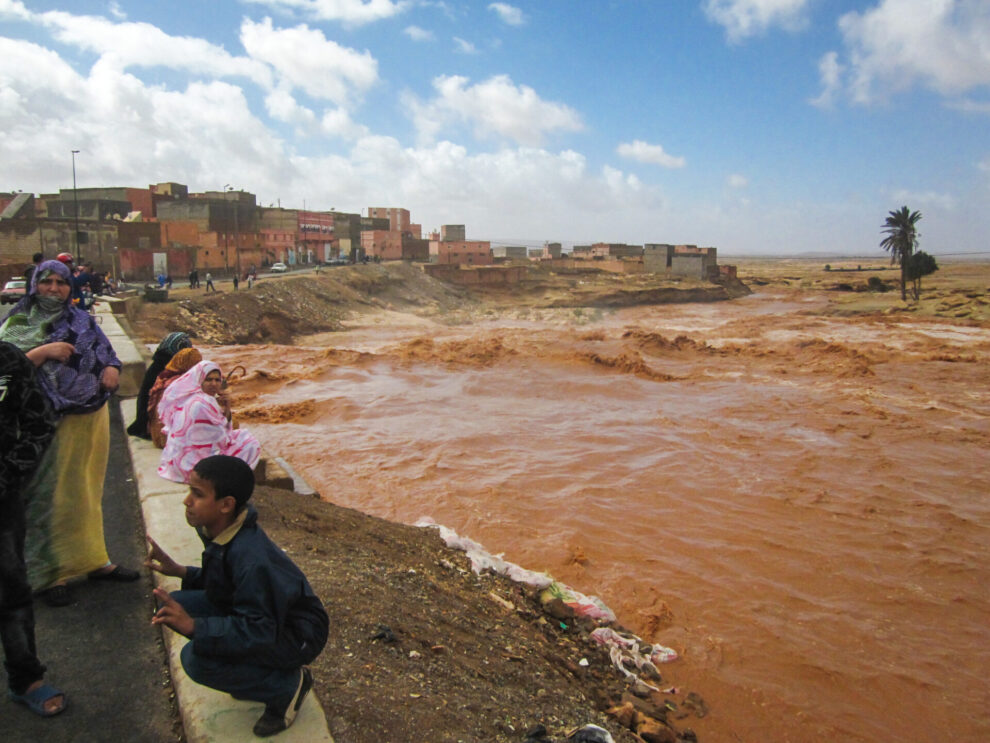Ilaria Manunza has seen floods in Niger get more intense and more frequent in recent years.
For a place so reliant on agriculture, a changing climate presents significant challenges, especially against a backdrop of fractured governance and an already vulnerable economy. Changing weather patterns have contributed to instability that has driven conflict between farmers and herders competing for scarce resources there, said Manunza, the Niger country director for Save the Children. She’s seen many in rural areas surviving day by day, with few reserves or backup plans to bounce back from climate shocks, she said.
“The floods wash away the crops. They have to start again, over and over. There are no food stocks in case of a drought,” Manunza said.
With few options, thousands of people from the Sahel — many of them under 25 — leave Niger each month in an effort to reach Europe, often to travel to North Africa with the aim of crossing the Mediterranean Sea.
As of July 2023, migrant departures from Libya to Europe were at their highest point since 2017. The majority were from Niger, Egypt, Sudan, Chad and Nigeria, according to the European Union. Climate change is pushing up temperatures across the globe, especially in the Sahel region, as detailed by a 2021 U.N. report focused on climate change and migration.
Highly dependent on climate-sensitive livelihoods like herding and agriculture, countries in the Sahel region of Africa are some of the most vulnerable yet lowest carbon-emitting countries in the world, said Tom Ellison, Deputy Director of the Center for Climate and Security.
“They’re very high on the list of countries who are heavily affected by, but least responsible for climate change,” he said.
Manunza has witnessed these changes firsthand in Niger.Historically, most Nigeriens survived through subsistence farming, or as pastoralists raising cattle. But rapid swings between flooding and drought are making that increasingly difficult. It’s also heightened conflict as farmers try to expand their land and herders travel farther to find grazing land for their animals.
“You have rainfall patterns that are not real patterns anymore,” Manunza said. And after a drought, “even if it rains, it doesn’t mean that the land will be fertile. If it floods, it washes away everything, meaning that pasture may not be available where traditionally it used to be.”
Increasingly erratic climate patterns — and other factors, like conflict and weak governance — have fueled food insecurity in Niger for years. Forty-five percent of Nigerien children are considered chronically malnourished, according to a July update from the United States Agency for International Development (USAID).
Many people struggling in rural environments try to migrate first within their own countries, often to an urban area “because there are few other options,” said Alex de Sherbinin, author of the World Bank’s 2018 Groundswell Report on climate migration.
But “urban areas are not lands of opportunity for people,” he said. “You go to an urban area and you’re basically stuck in some kind of informal sector position, hawking stuff on the street, or trying to piece together a living. And I think that this propels some youth to say, ‘I gotta risk it all’” and leave the country, he said.
Climate change is one of many factors that influence migration, Ellison and other experts who study migration and climate change note, and it can be difficult to isolate and track.
Some studies ask migrants, “‘Why are you traveling?’ and it’s fairly rare for them to say ‘climate change,’ right?” Ellison said. “But they might say something like, ‘well, I couldn’t make a living,’ or ‘my neighborhood is too violent.’ And climate change certainly has an impact on things like agricultural livelihoods, or conflict.”
Climate change is “best understood as a shaping factor — a structural factor that can contribute to some of the more proximate causes of migration.
Climate change is “best understood as a shaping factor — a structural factor that can contribute to some of the more proximate causes of migration,” he said. “I don’t think most experts would say that climate change is typically the direct cause of migration except, perhaps, in the case of an acute disaster like a hurricane.”
Historically, Niger has itself been a host to thousands of migrants from surrounding countries — some passing through, others pausing to work in the country before continuing their journey to Europe. Traditionally, the country welcomed these migrants, but as its own resources have been strained, tension has grown.
“Lack of sanitation, lack of water, extreme weather — it’s easy to understand how these can lead to conflict between the local community and migrants,” Manunza said.
A country like Niger, one of the lowest-emitting countries in the world, needs financial support for climate adaptation, Ellison said — helping its urban areas better accommodate large numbers of people moving in from rural areas, for example, or adapting farming techniques, or helping to resolve conflicts between farmers and herders.
Looking at current migration trends in the Mediterranean, Ian Urbina, director of the Outlaw Ocean Project, which has reported extensively on the peril of migrants crossing the Mediterranean, had grim predictions for how all of these compounding issues would play out.
“I think it’s also a forecast, in the sense that a lot of the very people that are crossing this watery desert are a sign of what’s to come in terms of climate migration,” he said. “Large numbers of especially desperate people willing to buy their way with traffickers, boats and across borders — that’s only going to increase with climate change.”
Source: PBSO
















